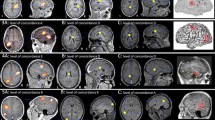Abstract
Patients with medically intractable partial epilepsy and well-defined symptomatic MRI lesions were studied using phase-encoded frequency spectral analysis (PEFSA) combined with low-resolution electromagnetic tomography (LORETA). Ten patients admitted to the epilepsy monitoring unit with MRI-identified lesions and intractable partial epilepsy were studied using 31-electrode scalp EEG. The scalp electrodes were located in three-dimensional space using a magnetic digitizer and coregistered with the patient's MRI. PEFSA was used to obtain a phase-encoded scalp map for the ictal frequencies. The ictal generators were obtained from the scalp map using LORETA. In addition, the generators of interictal epileptogenic spikes were identified using time-domain LORETA. The LORETA generators were rostral to the MRI lesion in 87% (7/8) of patients with temporal lobe lesions, but all were located in the mesial temporal lobe in concordance with the patients' MRI lesions. In patients with frontal lobe epilepsy, the ictal generators at the time that the spectral power was maximal localized to the MRI lesions. Eight of 10 patients had interictal spikes, of which 4 were bilateral independent temporal lobe spikes. Only generators of the interictal spikes that were ipsilateral to seizure onset correlated with the ictal generators. LORETA combined with PEFSA of the ictal discharge can localize ictal EEG discharges accurately and improve correlation with brain anatomy by allowing coregistration of the ictal generator with the MRI. Analysis of interictal spikes was less useful than analysis of the ictal discharge.
Similar content being viewed by others
References
Assaf, B.A. and Ebersole, J.S. Continuous source imaging of scalp ictal rhythms in temporal lobe epilepsy. Epilepsia, 1997, 38(10): 1114-1123.
Cascino, G.D., Boon, P.A.J.M. and Fish, D.R. Surgically remediable lesional syndromes. In: J. Engel, Jr. (Ed.), Surgical Treatment of the Epilepsies. Second edition. Raven Press, New York, 1993: 77-86.
Cascino, G.D. and Jack, C.R., Jr. Neuroimaging in epilepsy: Principles and Practice. Butterworth-Heinemann, Boston, 1996.
Czerwinski, R.N. and Jones, D.L. Adaptive cone-kernal time-frequency analysis. IEEE Trans Signal Processing, 1995, 43: 1715-1719.
Ebersole, J.S. EEG dipole modeling in complex partial epilepsy. Brain Topogr., 1991, 4(2): 113-123.
Ebersole, J.S. Realistic head models improve non-invasive EEG dipole localization of spike foci (Abstract). Epilepsia, 1996, 37 Suppl., 5: 90.
Ebersole, J.S. Defining epileptogenic foci: past, present, future. J. Clin. Neurophysiol., 1997, 14(6): 470-483.
Ebersole, J.S. and Wade, P.B. Spike voltage topography identifies two types of frontotemporal epileptic foci. Neurology, 1991, 41(9): 1425-1433.
Engel, J., Jr. Historical perspectives and future direction. In: E. Wyllie (Ed.), The Treatment of Epilepsy: Principles and Practice. Second edition. Williams & Wilkins, Baltimore, 1997: 957-966.
Fender, D.H. Source localization of brain electrical activity. In: A.S. Gevins and A. Remond (Eds.), Methods of Analysis of Brain Electrical and Magnetic Signals. EEG Handbook, Vol. 1, Elsevier, Amsterdam, 1987: 355-403.
Fuchs, M., Wagner, M., Kohler, T. and Wischmann, H.A. Linear and nonlinear current density reconstructions. J. Clin. Neurophysiol., 1999, 16(3): 267-295.
Grave de Peralta-Menendez, R. and Gonzalez-Andino, S.L. A critical analysis of linear inverse solutions to the neuroelectromagnetic inverse problem. IEEE Trans. Biomed. Eng., 1998, 45(4): 440-448.
Greenblatt, R.E. Error analysis for multisphere approximation in EEG forward and inverse problems (Abstract). Brain Topogr., 1998, 11: 85.
Greenblatt, R.E. and Robinson, S.E. A simple head shape approximation for the 3 shell model. Brain Topogr., 1994, 6: 331.
Jack, C.R., Jr. Magnetic resonance imaging. Neuroimaging and Anatomy. Neuroimaging Clin. N. Am., 1995, 5(4): 597-622.
Lantz, G., Michel, C.M., Pascual-Marqui, R.D., Spinelli, L, Seeck, M., Seri, S., Landis, T. and Rosen, I. Extracranial localization of intracranial interictal epileptiform activity using LORETA (low resolution electromagnetic tomography). Electroencephalogr. Clin. Neurophysiol., 1997, 102(5): 414-422.
Lantz, G., Michel, C.M., Seeck, M., Blanke, O., Landis, T. and Rosen, I. Frequency domain EEG source localization of ictal epileptiform activity in patients with partial complex epilepsy of temporal lobe origin. Clin. Neurophysiol., 1999, 110(1): 176-184.
Lehmann, D. and Michel, C.M. Intracerebral dipole source localization for FFT power maps. Electroencephalogr. Clin. Neurophysiol., 1990, 76(3): 271-276.
Lopes da Silva, F. EEG analysis: theory and practice. In: E. Niedermeyer and F. Lopes da Silva (Eds.), Electroencephalography: Basic Principles, Clinical Applications, and Related Fields. Fourth edition. Williams & Wilkins, Baltimore, 1999: 1135-1164.
Michel, C.M., Grave de Peralta, R., Lantz, G., Gonzalez Andino, S., Spinelli, L., Blanke, O., Landis, T. and Seeck, M. Spatiotemporal EEG analysis and distributed source estimation in presurgical epilepsy evaluation. J. Clin. Neurophysiol., 1999, 16(3): 239-266.
Michel, C.M., Lehmann, D., Henggeler, B. and Brandeis, D. Localization of the sources of EEG delta, theta, alpha and beta frequency bands using the FFT dipole approximation. Electroencephalogr. Clin. Neurophysiol., 1992, 82(1): 38-44.
Nunez, P.L. Electric fields of the brain: the neurophysics of EEG. Oxford University Press, New York, 1981: 324.
Pascual-Marqui, R.D., Michel, C.M. and Lehmann, D. Low resolution electromagnetic tomography: a new method for localizing electrical activity in the brain. Int. J. Psychophysiol., 1994, 18(1): 49-65.
Rush, S. and Driscoll, D.A. Current distribution in the brain from surface electrodes. Anesth. Analg., 1968, 47(6): 717-723.
Wikswo, J.P., Jr., Gevins, A. and Williamson, S.J. The future of the EEG and MEG. Electroencephalogr. Clin. Neurophysiol., 1993, 87(1): 1-9.
Worrell, G.A., Lagerlund, T.D., Sharbrough, F.W., Brinkmann, B., Busacker, N. and O'Brien, T.L. Localization of the epileptic focus in patients with known (MRI) lesions using low resolution electromagnetic tomography (abstract). Brain Topogr., 1998, 11: 86.
Author information
Authors and Affiliations
Rights and permissions
About this article
Cite this article
Worrell, G.A., Lagerlund, T.D., Sharbrough, F.W. et al. Localization of the Epileptic Focus by Low-Resolution Electromagnetic Tomography in Patients with a Lesion Demonstrated by MRI. Brain Topogr 12, 273–282 (2000). https://doi.org/10.1023/A:1023407521772
Issue Date:
DOI: https://doi.org/10.1023/A:1023407521772




